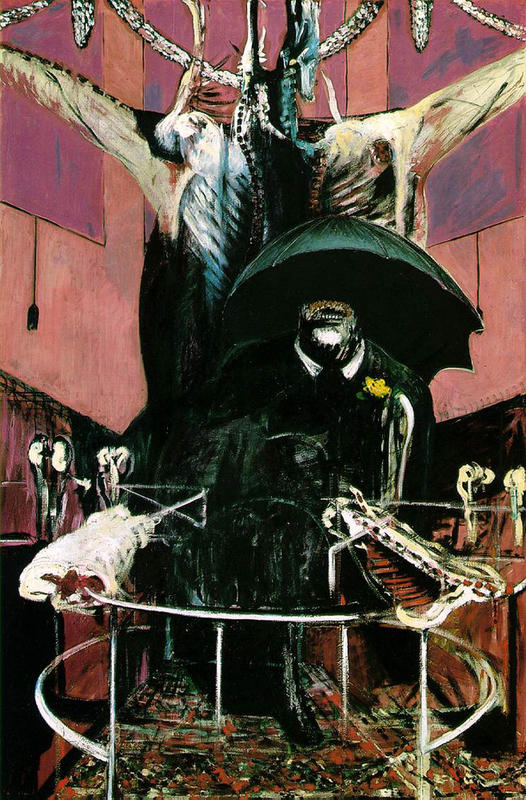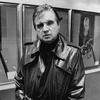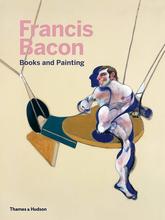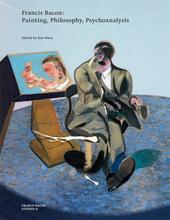More about Painting
- All
- Info
- Shop

Contributor
If you couldn’t have guessed from his name, Francis Bacon is going to disgust all those die-hard vegetarians out there.
So if you prefer to chow down on kale and quinoa, shield your eyes now or forever hold your peas!
A classic Bacon piece indeed, this painting marries all the elements that catapulted this man to stardom: unhappy men, dead animals, and an oddly religious tone. The man in this painting is anonymous, but we assume he is some sort of British political figure due to his outfit. A dark formal suit with yellow boutonniere was the unofficial attire of English politicians in the '40s. The formality of the outfit in conjunction with his terrifying, toothy grimace signals a menacing depravity that can lie within the most seemingly composed and responsible people.
Overhead hangs a disemboweled carcass, an ode to the crucifix. Bacon was obsessed with butcher shops from a young age. This type of imagery was part of his existential makeup, which paired well with the malevolent force that coursed through this tortured artist’s life.
A little disheartening, sure. But to put this one in perspective, it was made in the immediate aftermath of World War II. Commenting on the brutality of life was totally Bacon’s thing, and for those of us who apparently missed the memo that WWII was a blood bath...well, Bacon wanted to make sure that we would never forget it.
Some people knock Bacon's work for being too frightening and displeasing to the eye, but take a minute and realize that while you may have looked at his work for a few passing moments, he had to live with that terror everyday. What’s even more distressing about all this is that his work has gone for over $142 million in auction! A real testament to the old saying, "Beauty is in the eye of the beholder." Or the butcher, as the case may be.
Featured Content
Here is what Wikipedia says about Painting 1946
Painting 1946, also known as Painting or Painting (1946), is an oil-on-linen painting by the Irish-born artist Francis Bacon. It was originally intended to depict a chimpanzee in long grass (parts of which may be still visible); Bacon then attempted to paint a bird of prey landing in a field. Bacon described the work as his most unconscious, the figurations forming without his intention.
The previous year Poussin's The Adoration of the Golden Calf had been taken into the National Gallery collection and Bacon almost certainly had this painting in the back of his mind in respect of the garlands, the calf (now slaughtered) and the tented Israelite encampment, now transmuted into an umbrella.
Graham Sutherland saw Painting 1946 in the Cromwell Place studio, and urged his dealer, Erica Brausen, then of the Redfern Gallery, to go to see the painting and to buy it. Brausen wrote to Bacon several times and visited his studio in the early Autumn of 1946, promptly buying the work for £200. It was shown in several group showings, including the British section of Exposition internationale d'arte moderne (18 November – 28 December 1946) at the Musée National d'Art Moderne, for which Bacon travelled to Paris.
Within a fortnight of the sale of Painting 1946 to the Hanover gallery, Bacon had used the proceeds to decamp from London to Monte Carlo. After staying at a succession of hotels and flats, including the Hôtel de Ré, Bacon settled in a large villa, La Frontalière, in the hills above the town. Eric Hall and Nanny Lightfoot would come to stay. Bacon spent much of the next few years in Monte Carlo, apart from short visits to London. From Monte Carlo, Bacon wrote to Graham Sutherland and Erica Brausen. His letters to Erica Brausen show that he did paint there, but no paintings are known to survive.
In 1948, Painting 1946 sold to Alfred Barr for the Museum of Modern Art in New York. Bacon wrote to Sutherland asking that he apply fixative to the patches of pastel on Painting 1946 before it was shipped to New York. Painting 1946 is now too fragile to be moved from the museum for exhibition elsewhere.
Check out the full Wikipedia article about Painting 1946














